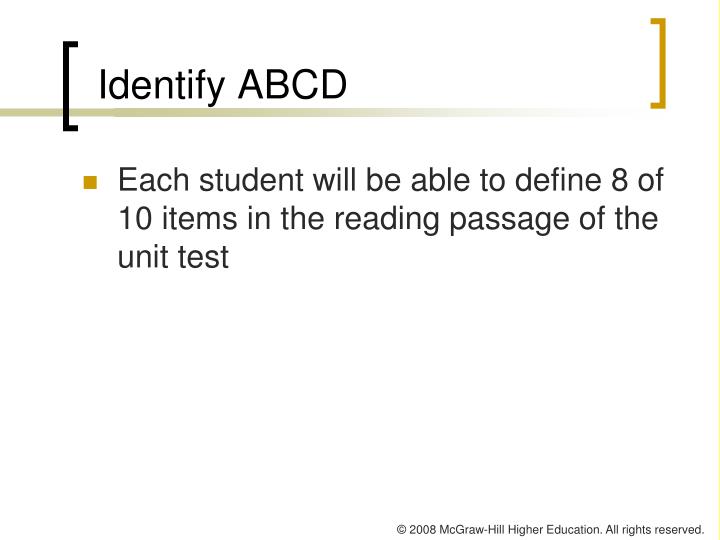

ABCD FORMAT HOW TO
Students will understand how to interpret classic literature. Instructor observation of student demonstration in a lab using a criterion checklist of critical steps for objective scoring. Given a sample of blood and two glass slides, students will demonstrate the prescribed method of obtaining a blood smear for microscopic analysis. Students will know how to analyze blood counts. AssessmentĪ traditional essay or essay exam.
ABCD FORMAT FREE
In at least 2 paragraphs, students will describe the conditions of free Blacks in pre-Civil War America, including 3 of 5 major points that were discussed in class. Students will know the conditions of free Blacks during antebellum south. Manipulate, operate, build, demonstrate (rules and principles)Īctivity: Suggests psychomotor (hands-on) assessments, design projects and prototypes, simulationsĪssessment: Checklists, videotape the sessionĪctivity: Case study, small group critical thinking, teamwork, pair shareĪssessment: Essays, research papers, discussion questionsĪctivity: Develop a portfolio, design a projectĮxamples of Linked Instructional Goals, Objectives, and Assessments Instructional Goal Source: adapted from Penn State University (2007) Level of Learning For KnowledgeĪctivity: Self-check quizzes, trivia games, word gamesĪssessment: Vocabulary test, matching item quizĪctivity: Have students show examples/non-examples, student-generated flowchartsĪssessment: Equations, word problems with given set of data Matching cognitive domain levels of learning (Bloom’s Taxonomy) with related student activities and assessments. For example, if you want your learners to be able to discriminate between good and bad apples, add the indicator behavior “sort” to the objective: Be able to discriminate (sort) the good apples from the bad apples. Overt behavior: If the behavior is covert or not typically visible when observed, such as the word discriminate, include an indicator behavior to clarify to the student what she or he must be able to do to meet your expectations. See Verbs to Use in Creating Educational Objectives (based on Bloom’s Taxonomy) at the end of this guide. Use these words in your course goals but not when writing learning objectives. On the other hand, words such as understand, appreciate, internalize, and value are not appropriate when writing learning objectives because they are not measurable or observable. You can use action verbs such as calculate, read, identify, match, explain, translate, and prepare to describe the behavior further. The key to writing learning objectives is using an action verb to describe the behavior you intend for students to perform. Objectives are measurable and observable, while goals are not. Learning Objectives are different from goals in that objectives are narrow, discrete intentions of student performance, whereas goals articulate a global statement of intent. Once you have written your course goals, you should develop learning objectives. We cannot stop at course goals we need to develop measurable objectives. Students will understand the laws of gravity.Students will learn key elements and models used in education.Students’ perspective on civil rights will improve.Students will understand the effect of global warming.

Students will know how to communicate in oral and written formats.Exploration of period clothing, manners, décor, and architecture with projects from dramatic literature. Students will investigate period style from pre-Egyptian through the Renaissance as it relates to theatrical production. Students will understand the processes involved in the interactions between, spatial variations of, and interrelationships between hydrology, vegetation, landforms, and soils and humankind.
ABCD FORMAT PROFESSIONAL
Students will learn about personal and professional development, interpersonal skills, verbal and written presentation skills, sales and buying processes, and customer satisfaction development and maintenance. You should also discuss course goals with your colleagues who teach the same class so that you can align your goals to provide students with a somewhat consistent experience of the course. Course goals often originate in the course description and should be written before developing learning objectives. Your ideas can then generate course-related goals. If you have difficulty defining a course goal, brainstorm reasons your course exists and why students should enroll in it. Course goals often do not specify student outcomes or how outcomes will be assessed. The goal “prepare students” specifies the big picture or general direction or purpose of the course.


 0 kommentar(er)
0 kommentar(er)
